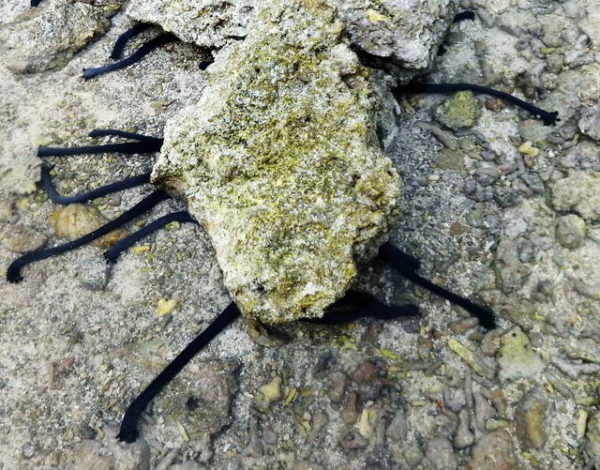Published in the Ocean Watch column, Honolulu Star-Advertiser © Susan Scott
July 1, 2017
Two weeks ago I picked up a flu bug that knocked me sideways. Aching muscles and violent coughing kept me down for days. Then one morning last week, I had enough. Sick or not, I had to get in the water.
The calm blue water off Lanikai felt soothing in the hot afternoon sun. Not feeling like swimming hard, I drifted over the sand in the shallows and, of course, discovered something marvelous.
 Sea cucumbers don’t use muscles to tighten and relax their
Sea cucumbers don’t use muscles to tighten and relax their
body walls, so they expend little energy to stay anchored.
©2017 Susan Scott
The walls that some people have built in front of their beach houses cause the waves to reflect back and forth, creating swirls of bumpy water that stirs up the bottom. I don’t usually swim there because the surface is rough and the water cloudy with sand. But I’ve been missing out.
Black sea cucumbers have anchored their bodies under the rocky rubble there with their head ends poking out. And extended from the heads were the creatures’ feathery tentacles, happily vacuuming up the nutrients in the turbulent water.
I say happily because as I floated around the area, I found dozens of the creatures tucked under rocks and Hoovering away.
Sea cucumbers are easy to pass by because they usually look like plump, sand-covered sausages lying motionless on the ocean floor. But these leathery creatures can walk, some species moving slowly on sticky tube feet, and others inching along in waves, like worms.
When the water is too rough for the sea cucumber to keep its place, it crawls under or leans against a rock and molds itself there, using a remarkable feature in its body walls.
Sea cucumber skin contains microscopic bones shaped like anchors, buttons, tables and tripods. No one knows why the bones’ shapes are so varied, but each species has its own set. Researchers can identify one sea cucumber from another by studying its tiny skin bones.
At rest on the ocean floor, the sea cucumber’s little bones connect with one another with medium tension. But startle the animal, such as by picking it up, and the connections between the bones quickly tighten, turning the sea cucumber into a hard, solid mass.
The opposite occurs when the creature needs to squeeze into a small space. The tiny skin bones spread far apart, and their connections loosen, making the skin soft and flexible. Once the animal gets in the gap, the skin turns firm again, mooring the sea cucumber for as long as it wants to stay there.
Because sea cucumbers don’t use muscles to tighten and relax their body walls, the creatures use little energy to stay anchored.
Some practitioners of traditional Chinese medicine use sea cucumbers as a remedy for various illnesses, but I didn’t have to swallow any sea cucumber to get well. Just watching those animals clean up the ocean floor made me feel better than I had in days. Now that’s powerful medicine.